SLS Lecture 13 : Program Anatomy IV: The Tree of Bytes and Data Structures
Contents
13. SLS Lecture 13 : Program Anatomy IV: The Tree of Bytes and Data Structures#
create a directory
mkdir datastructs; cd datastructscopy examples
add a
Makefileto automate assembling and linkingwe are going run the commands by hand this time to highlight the details
add our
setup.gdbandtree.gdbto make working in gdb easiernormally you would want to track everything in git
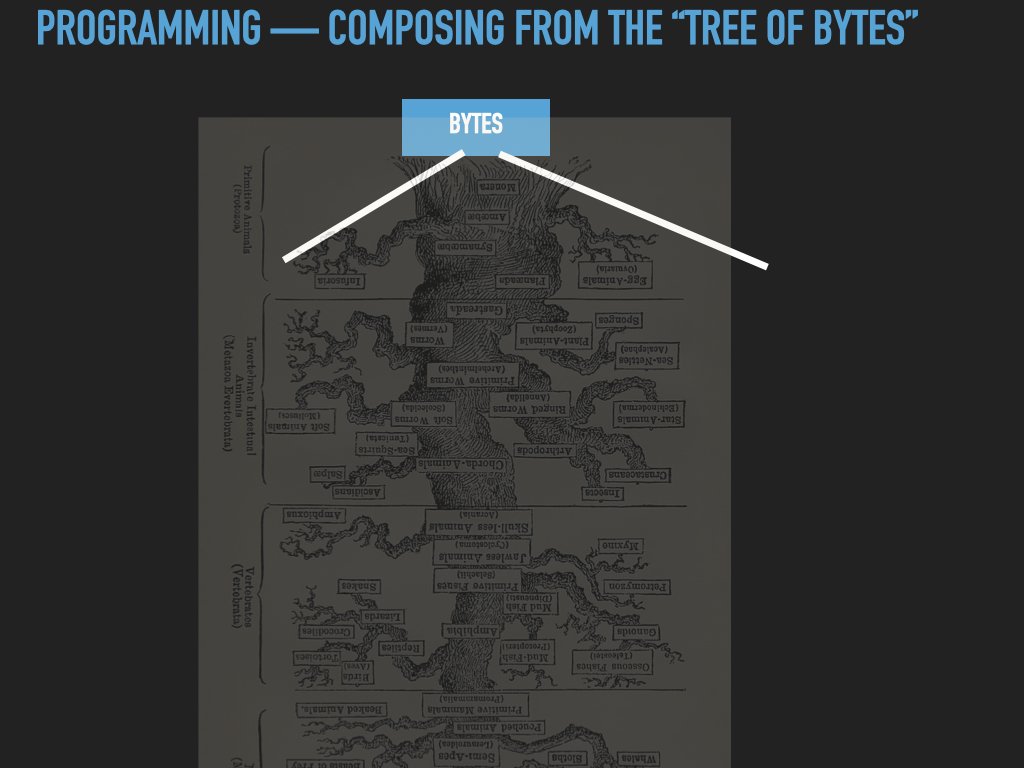
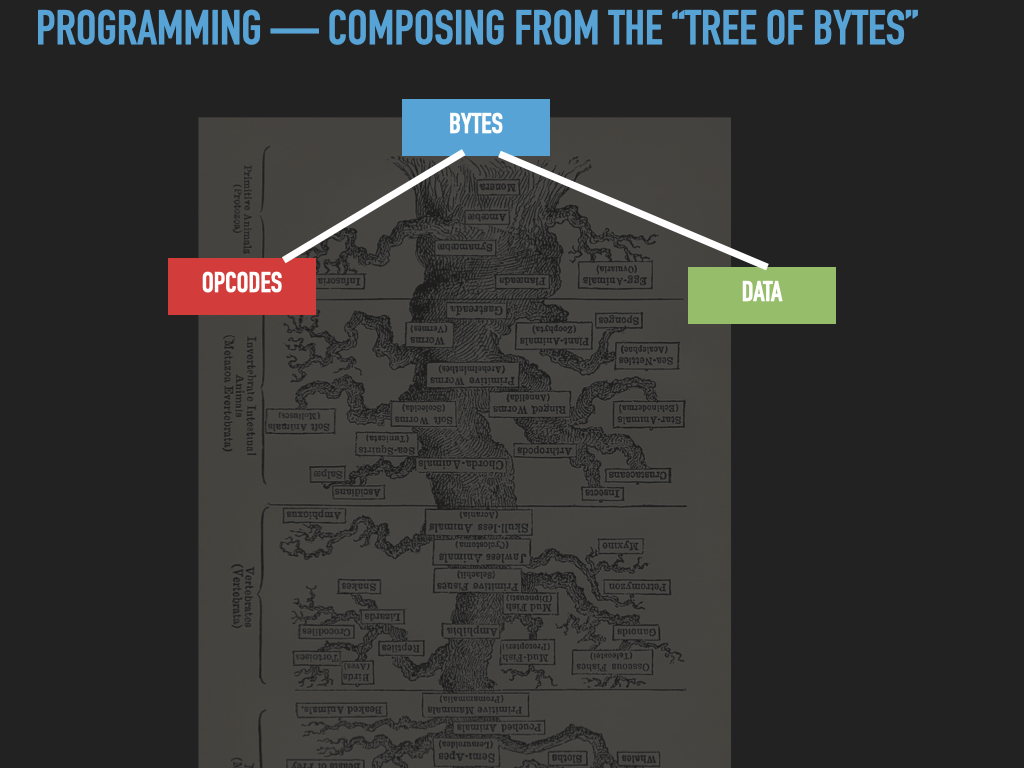
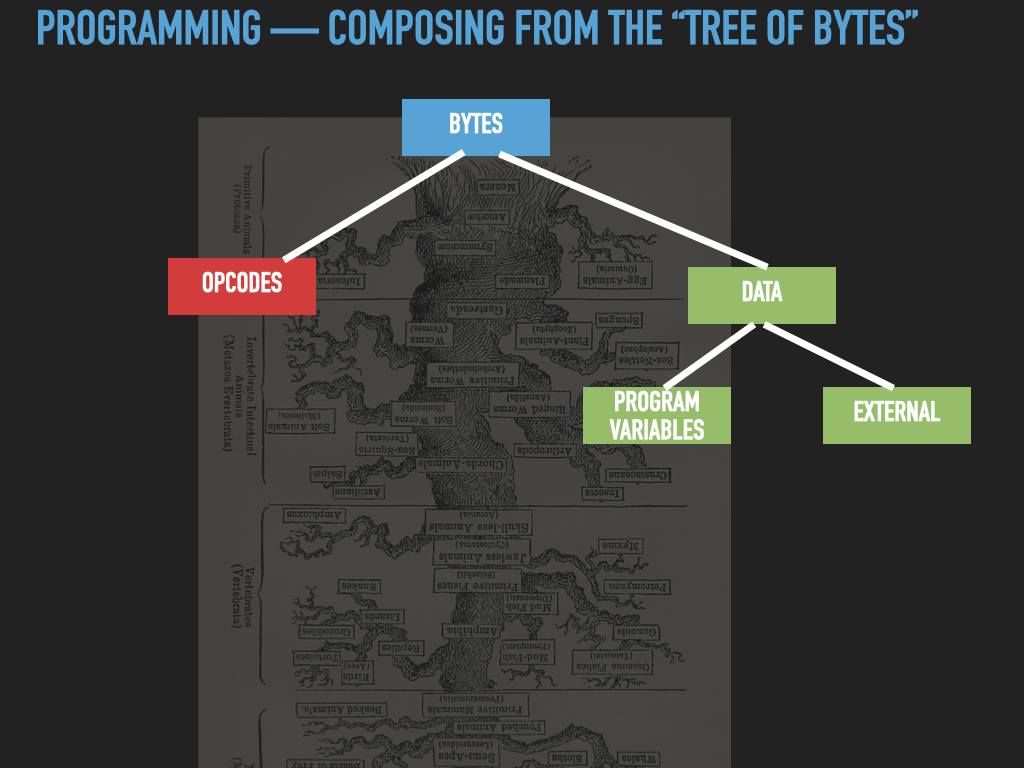
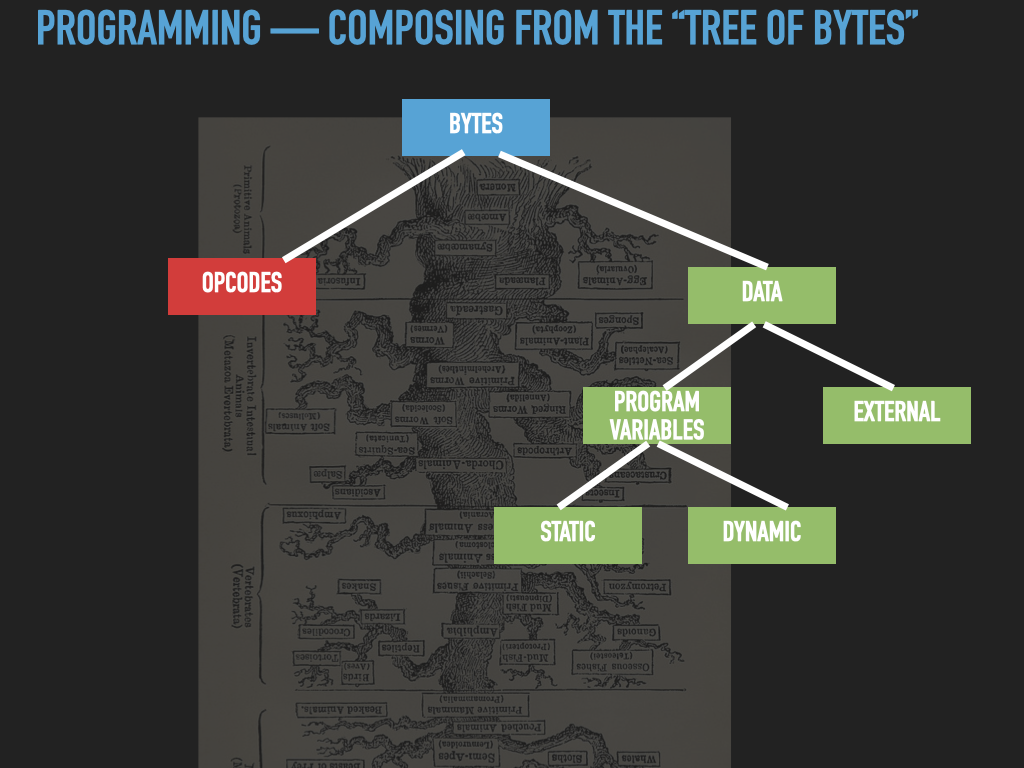

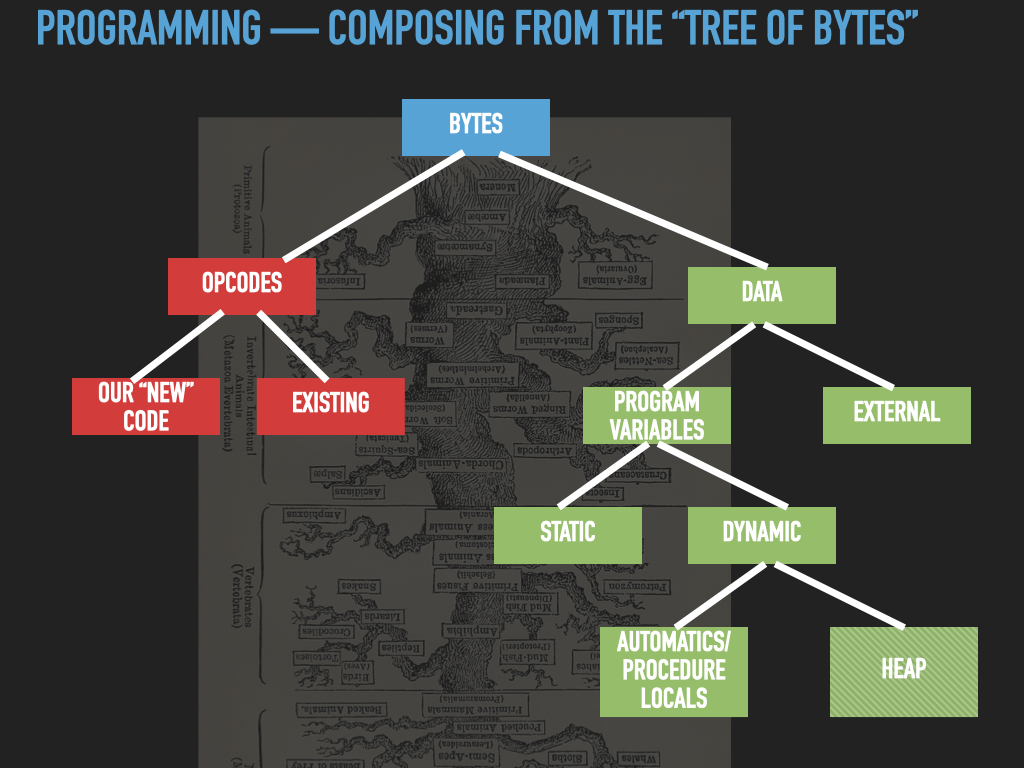
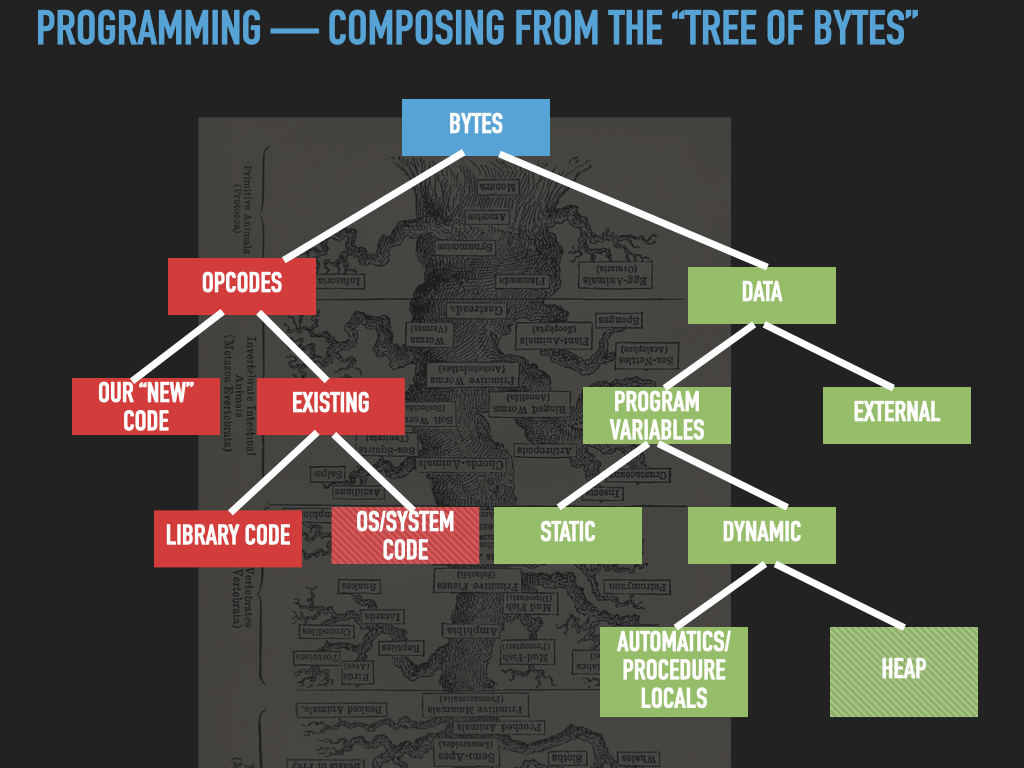
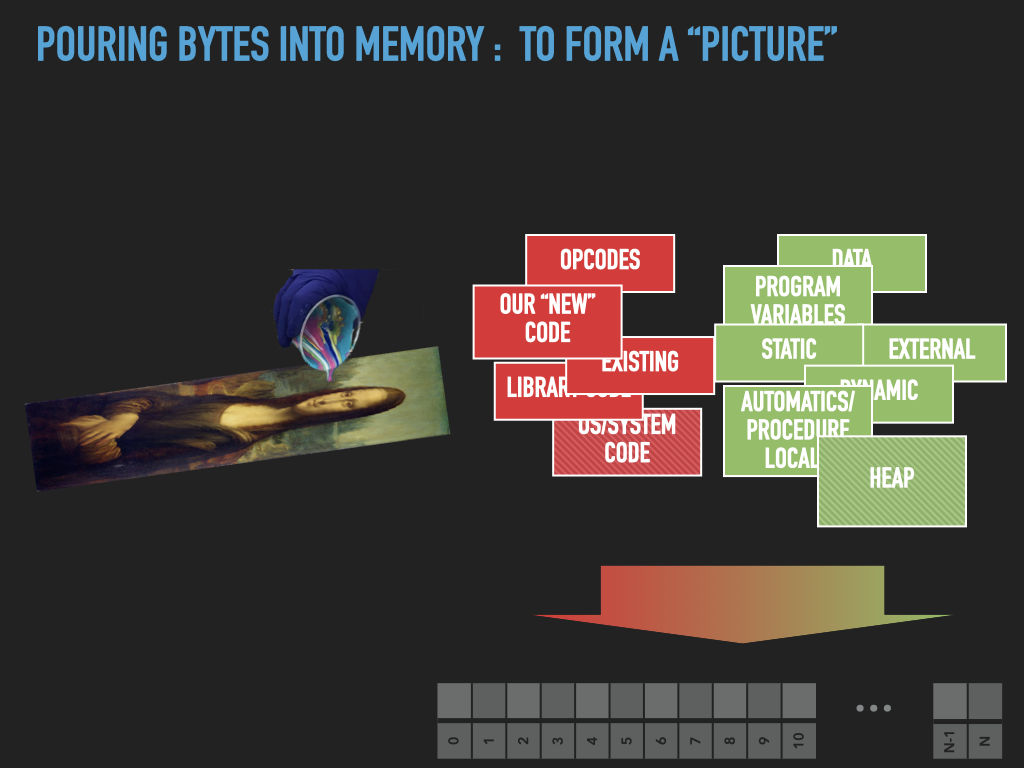
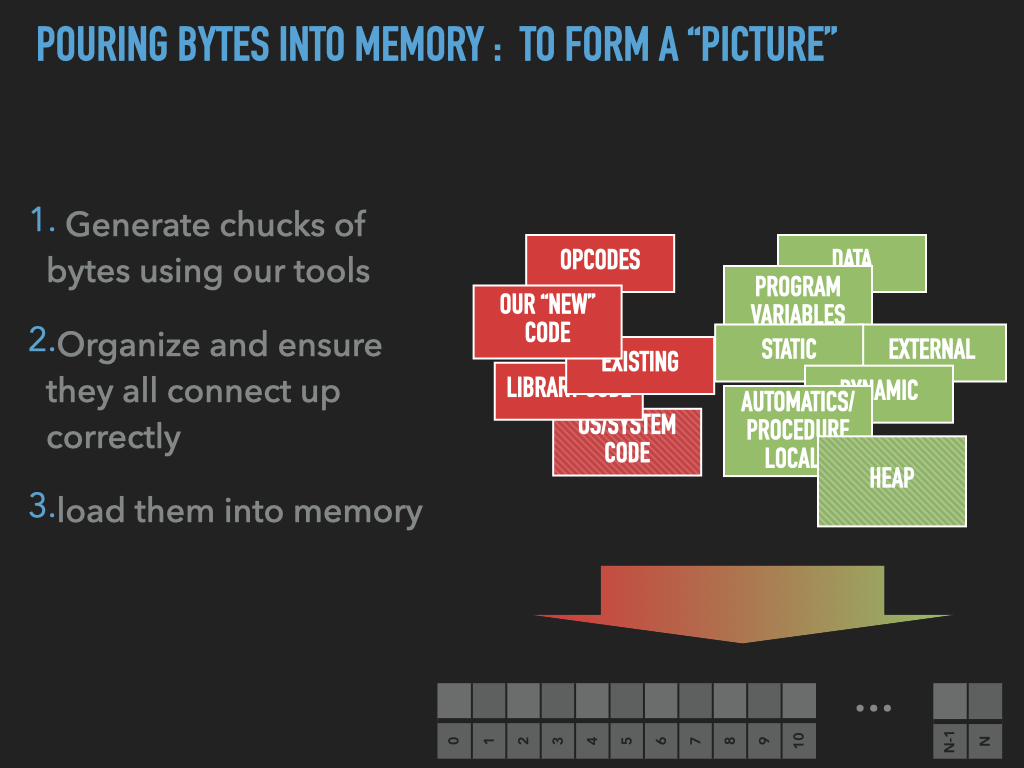
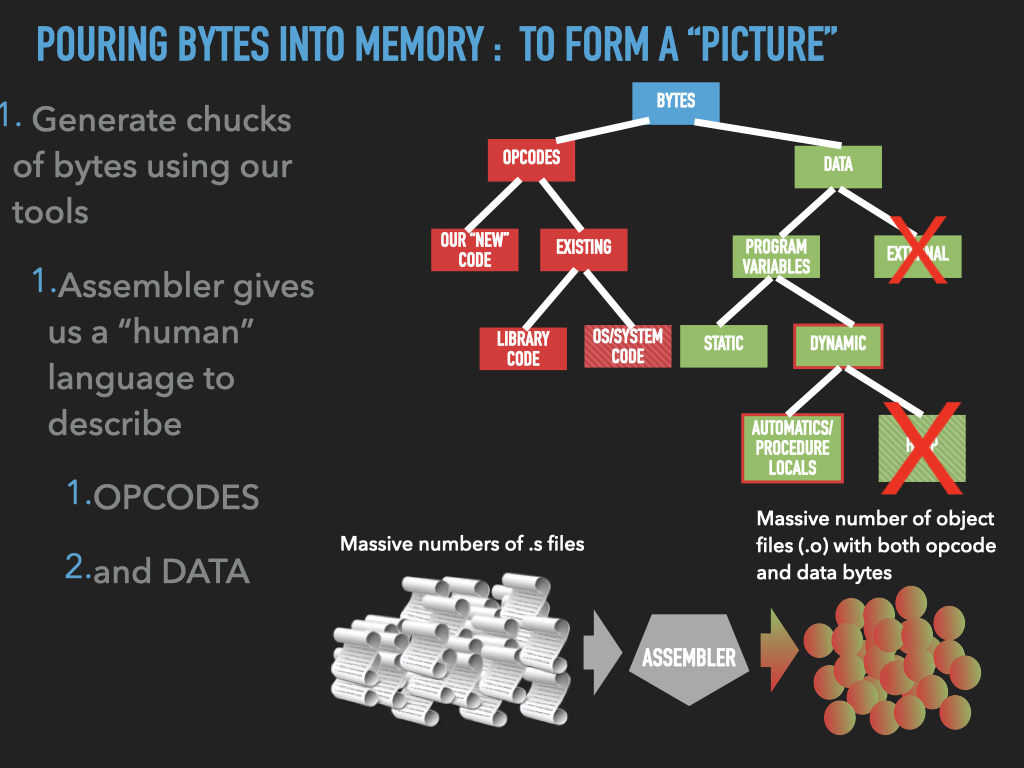

13.1. Overview#
REMEMBER A DATA STRUCTURE ENDS UP AS …
Bytes in memory
At particular locations – Memory Address
taking up some number of contiguous bytes
Intrinsic types : groups of bytes that the processor has built in “interpretations” for
bit vectors of various lengths (1,2,4,8,16,…)
signed and unsigned integers (1,2,4,8,16,…)
floating point number (IEEE 754)
Complex data structures often are broken into pieces
each piece connected to others
connections formed via Addresses
pieces record the address of the pieces it connects to
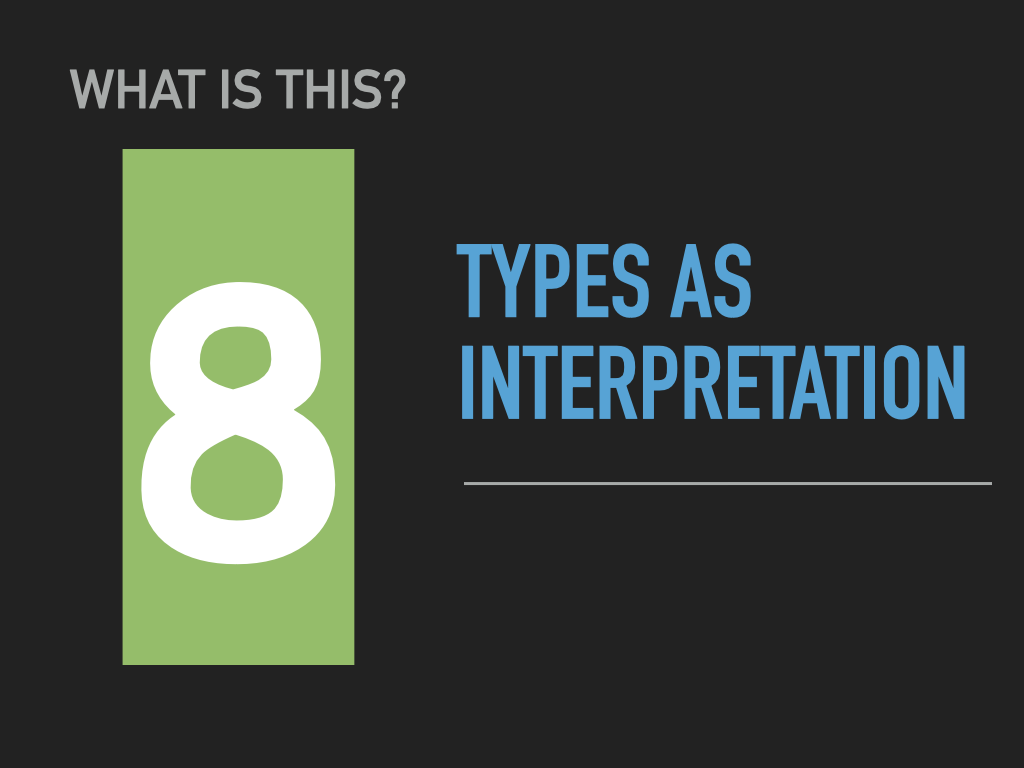
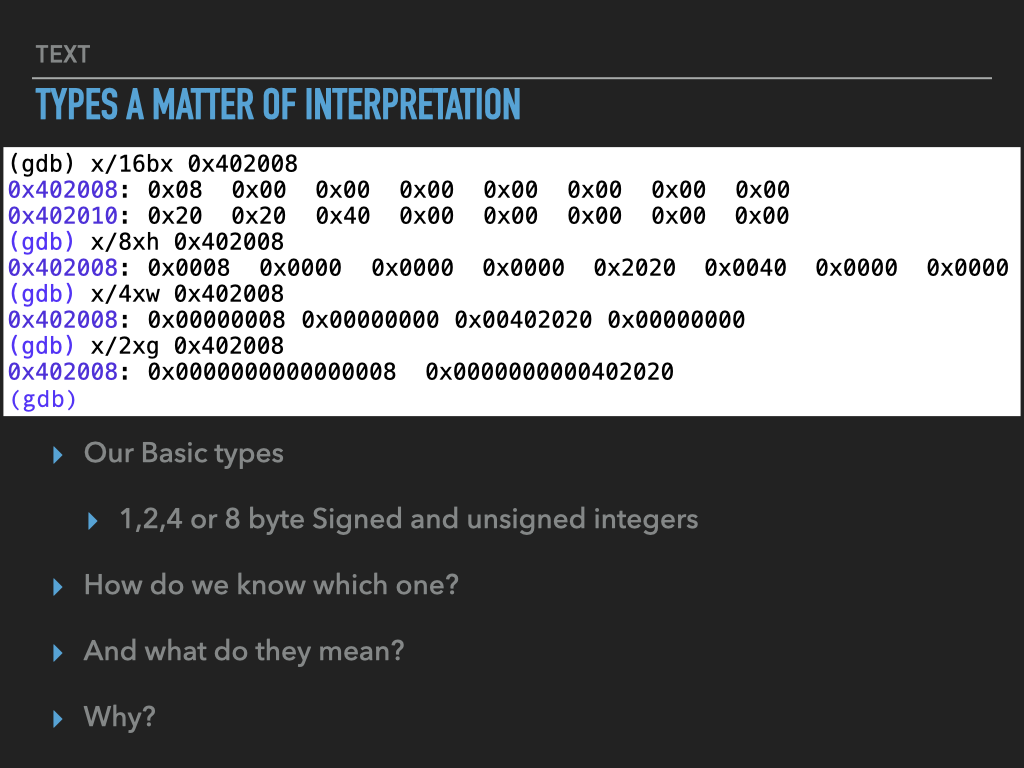
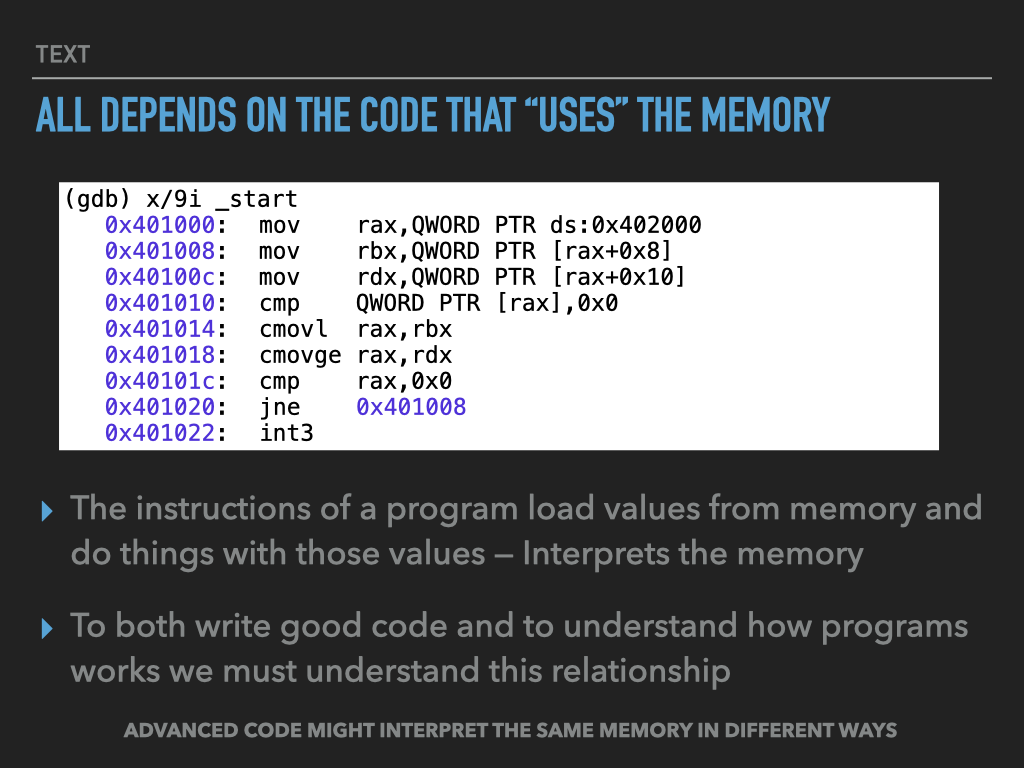

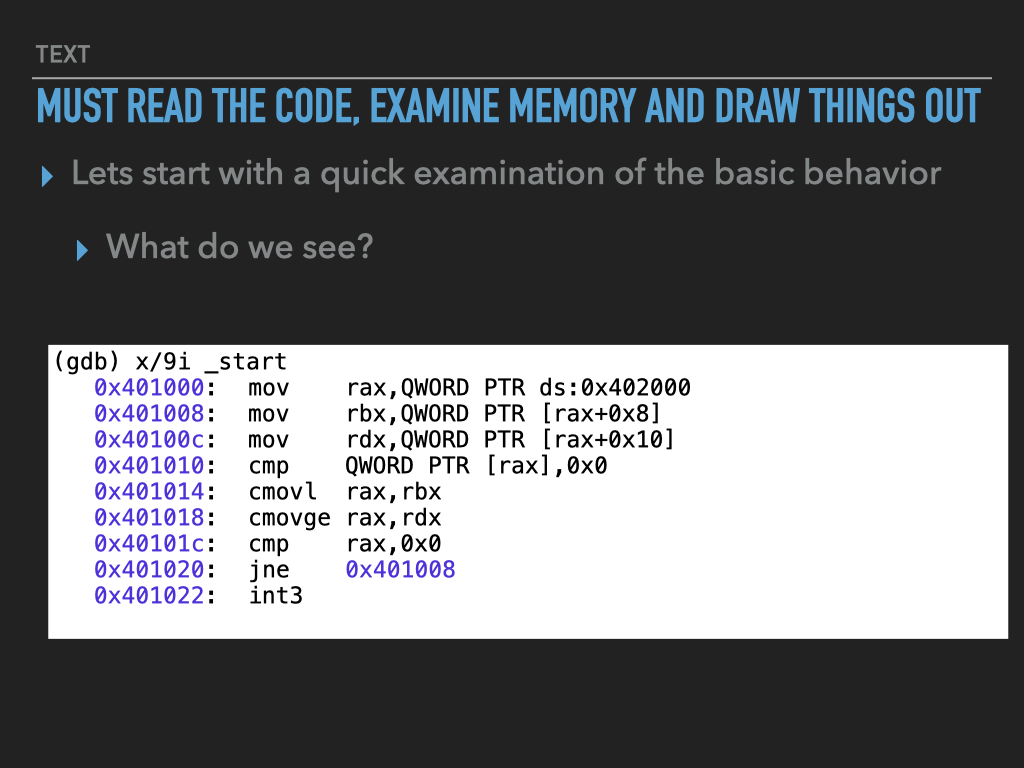
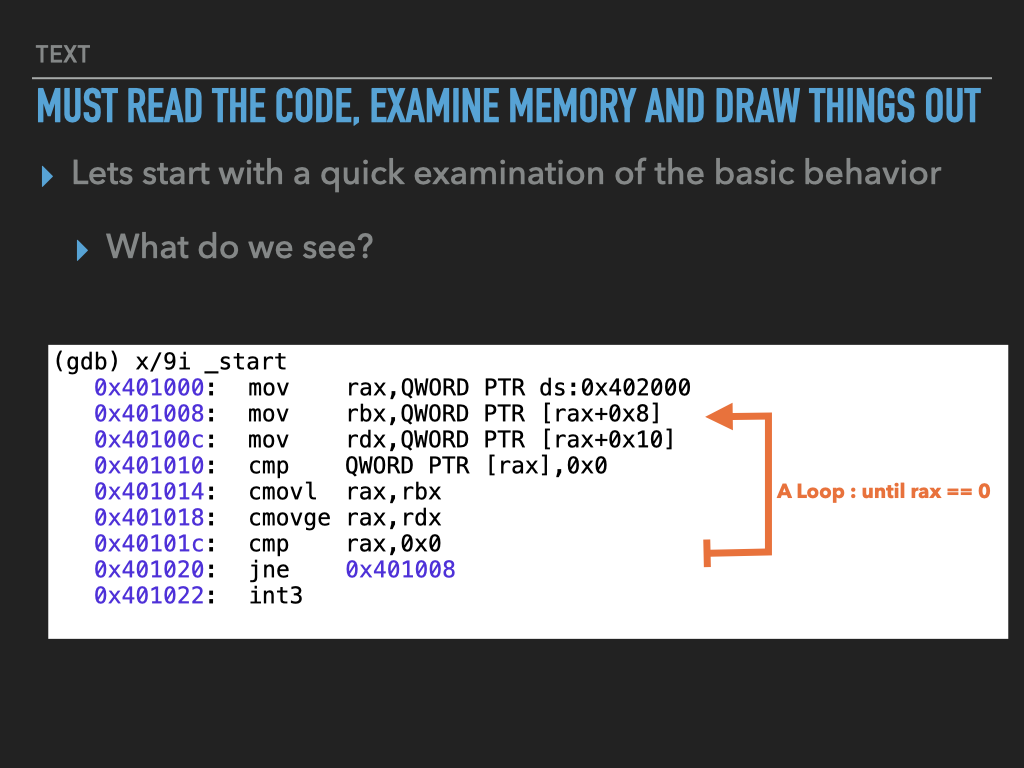
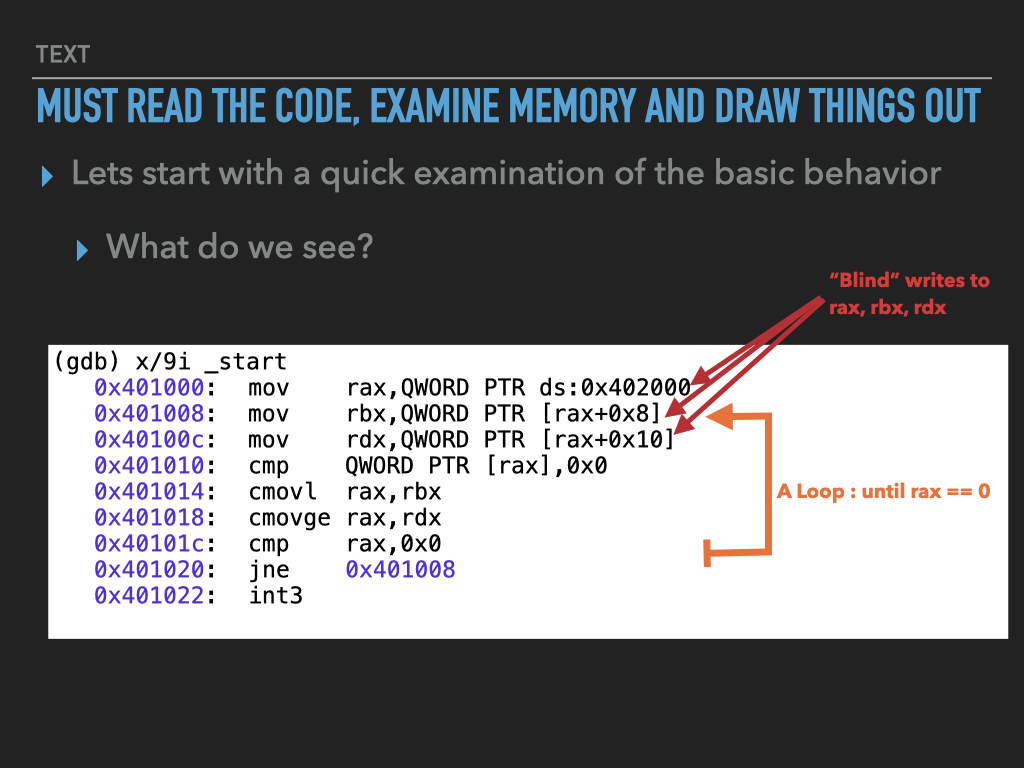
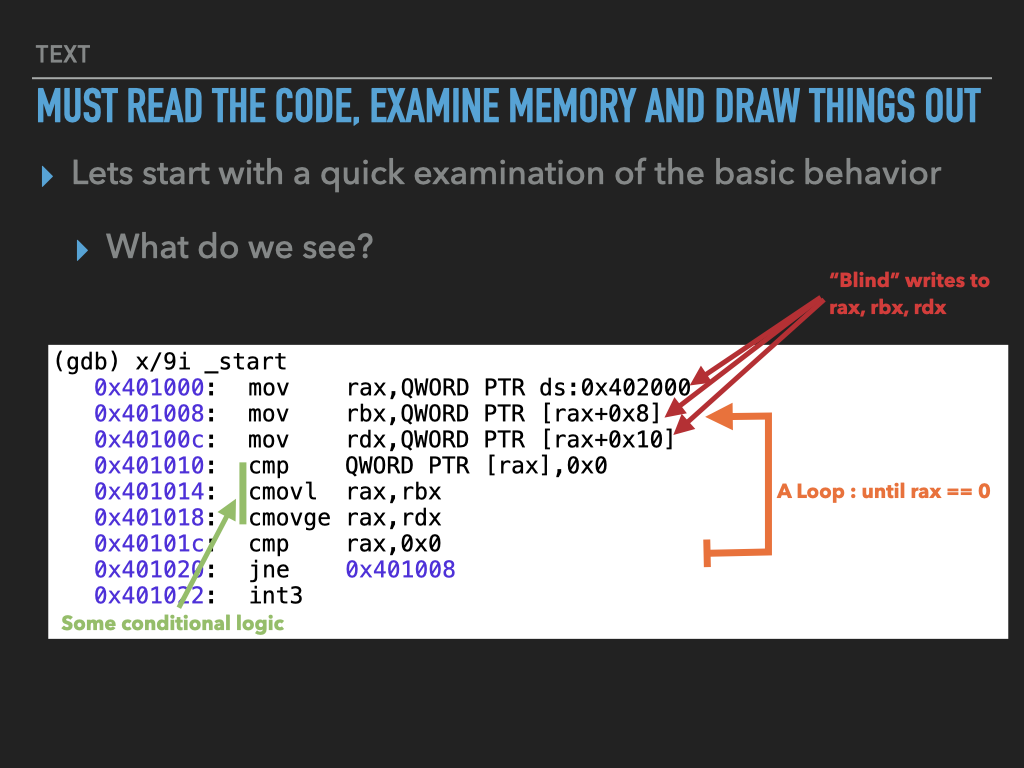

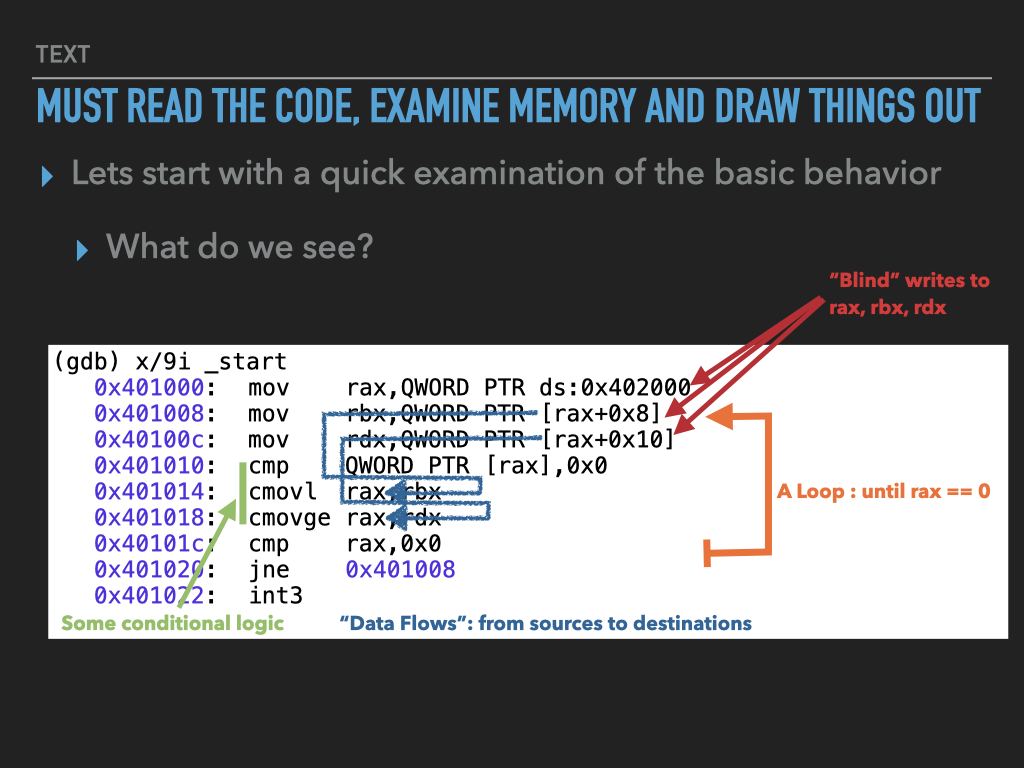
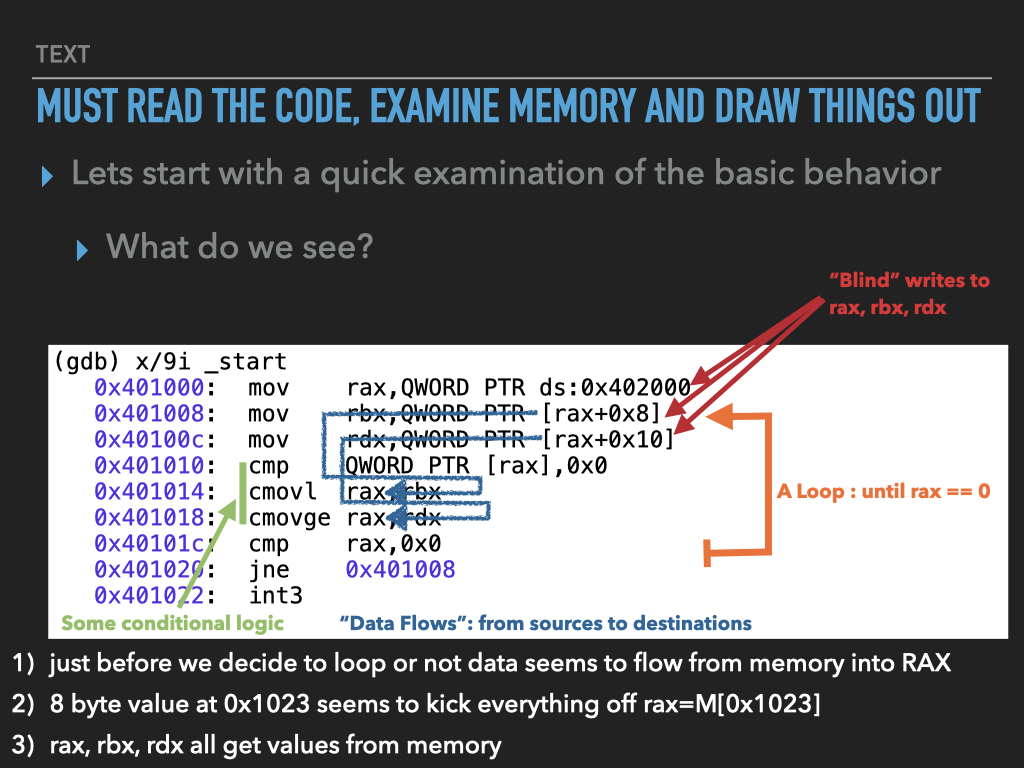
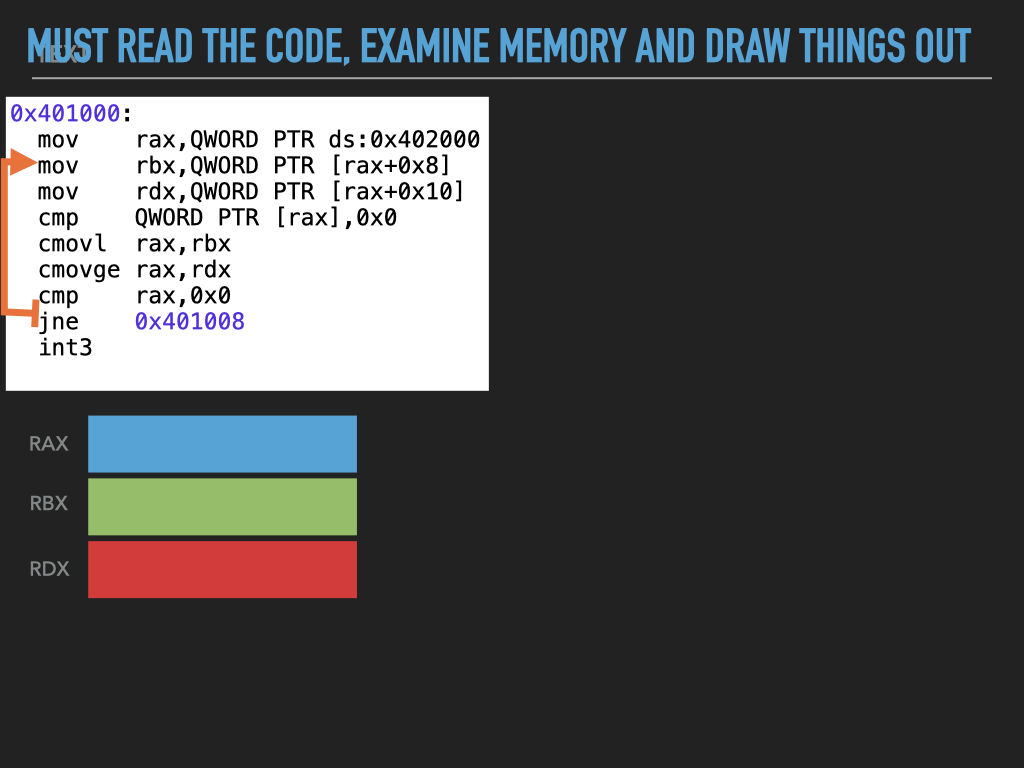
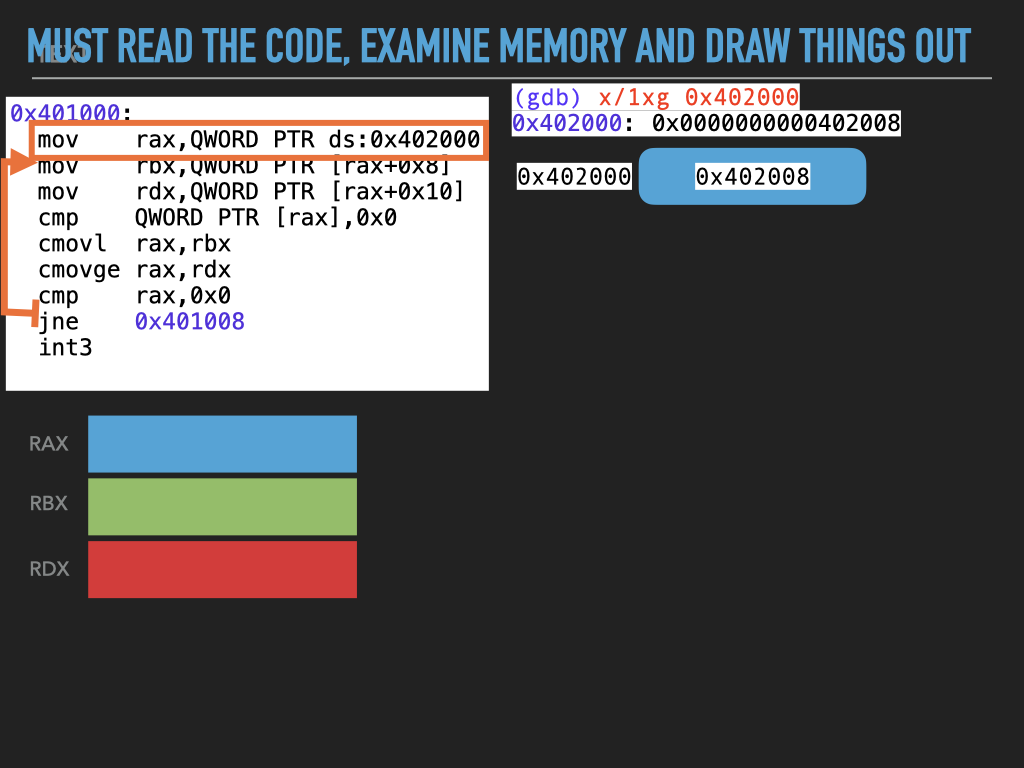
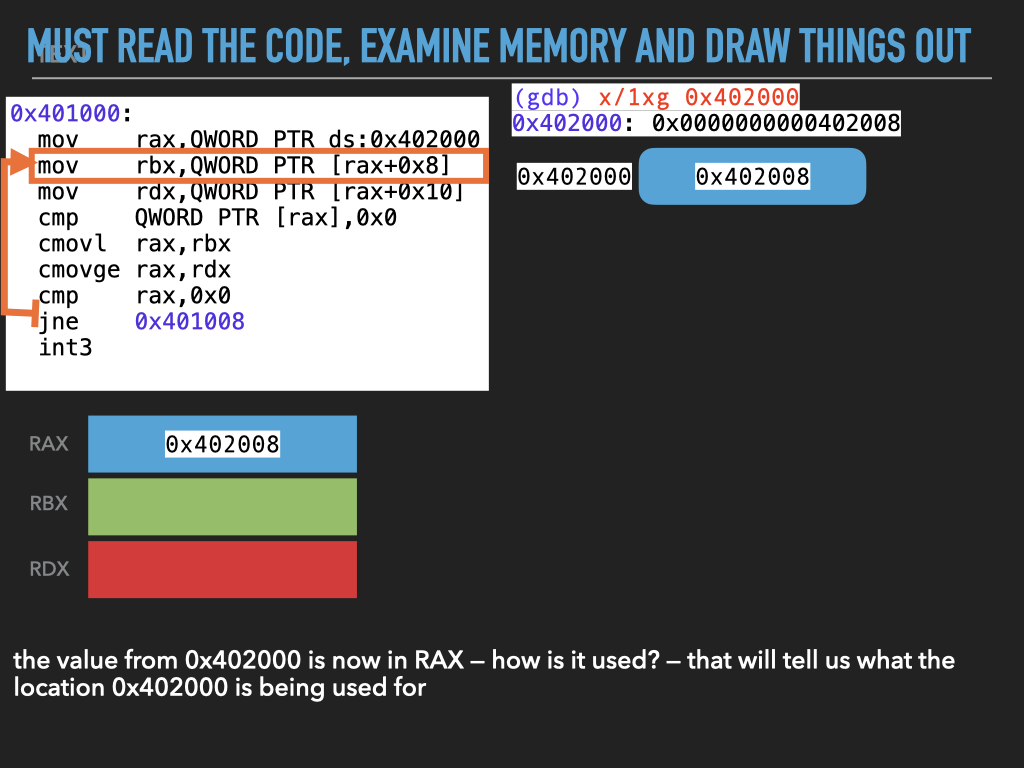
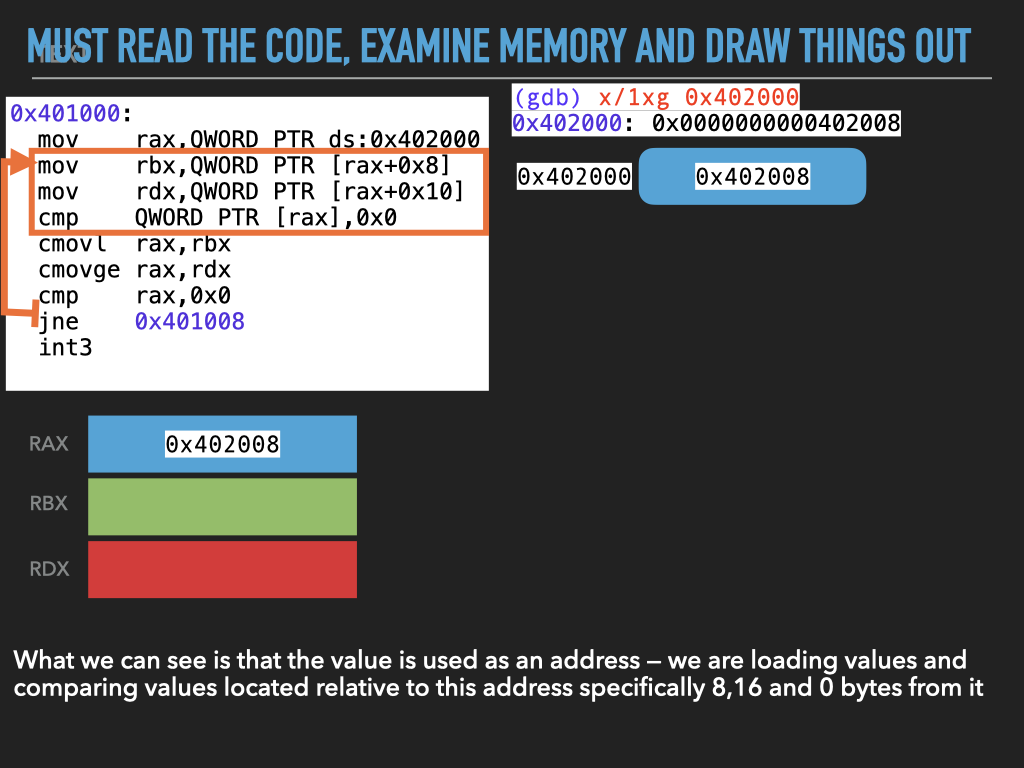
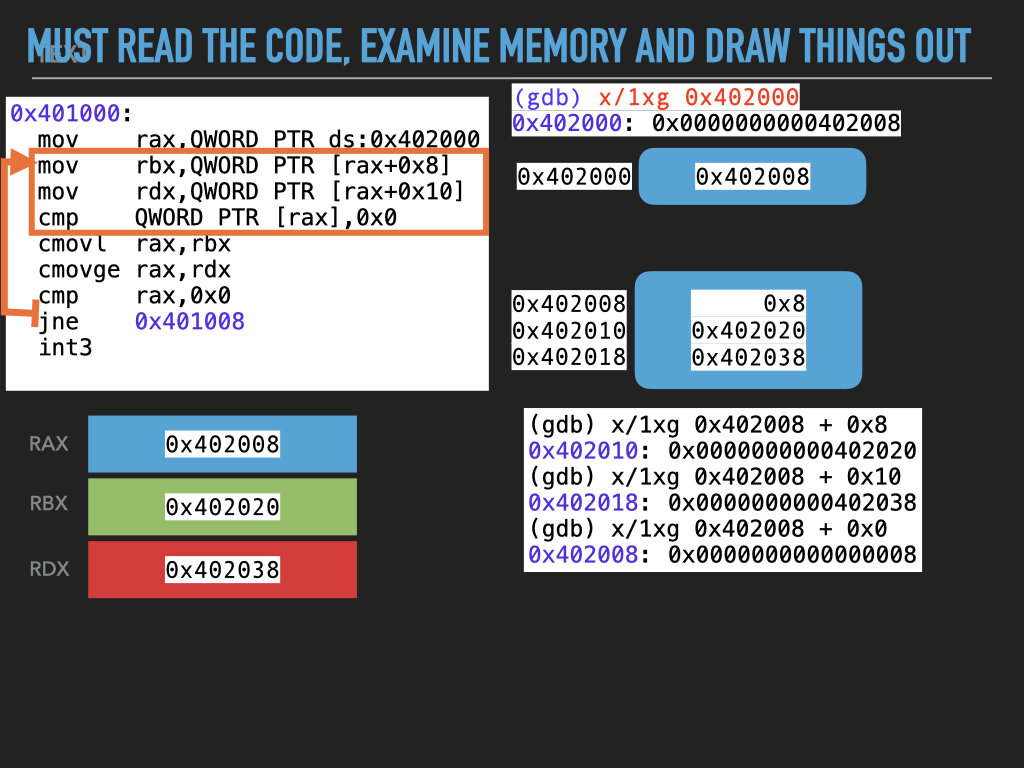
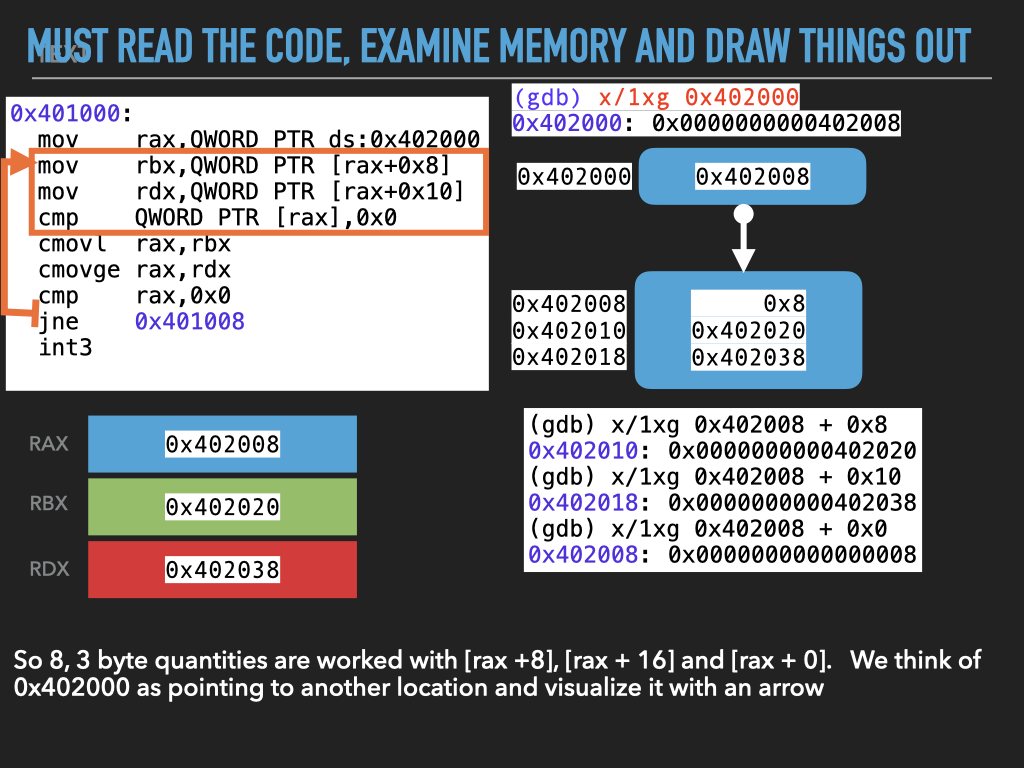
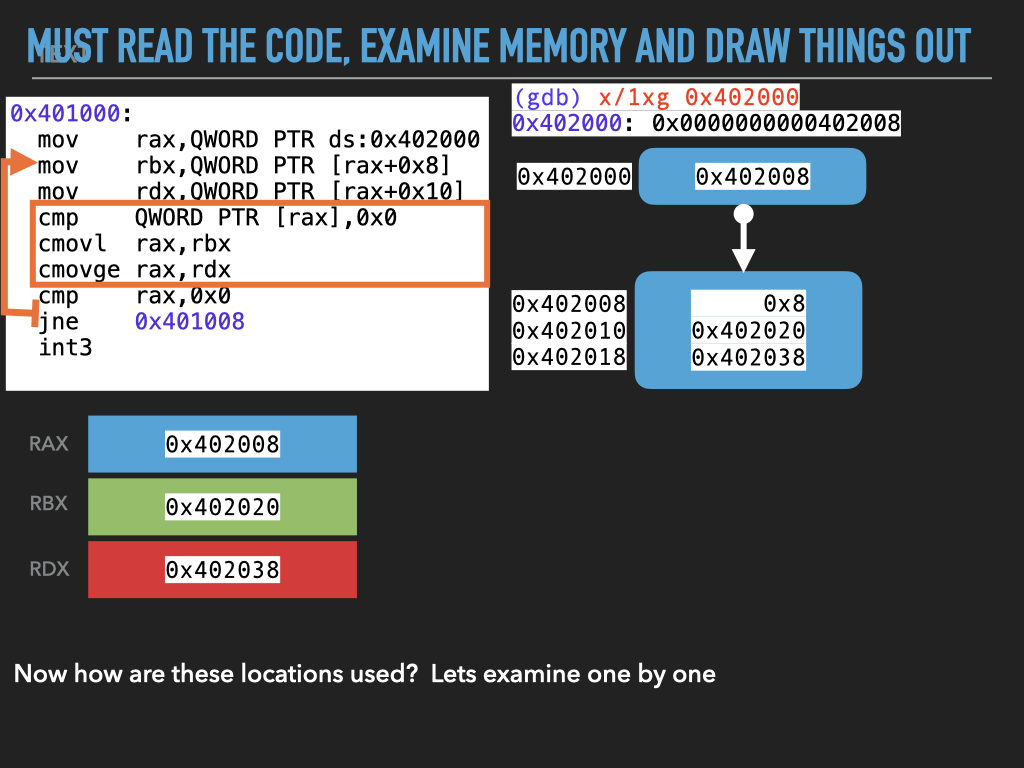


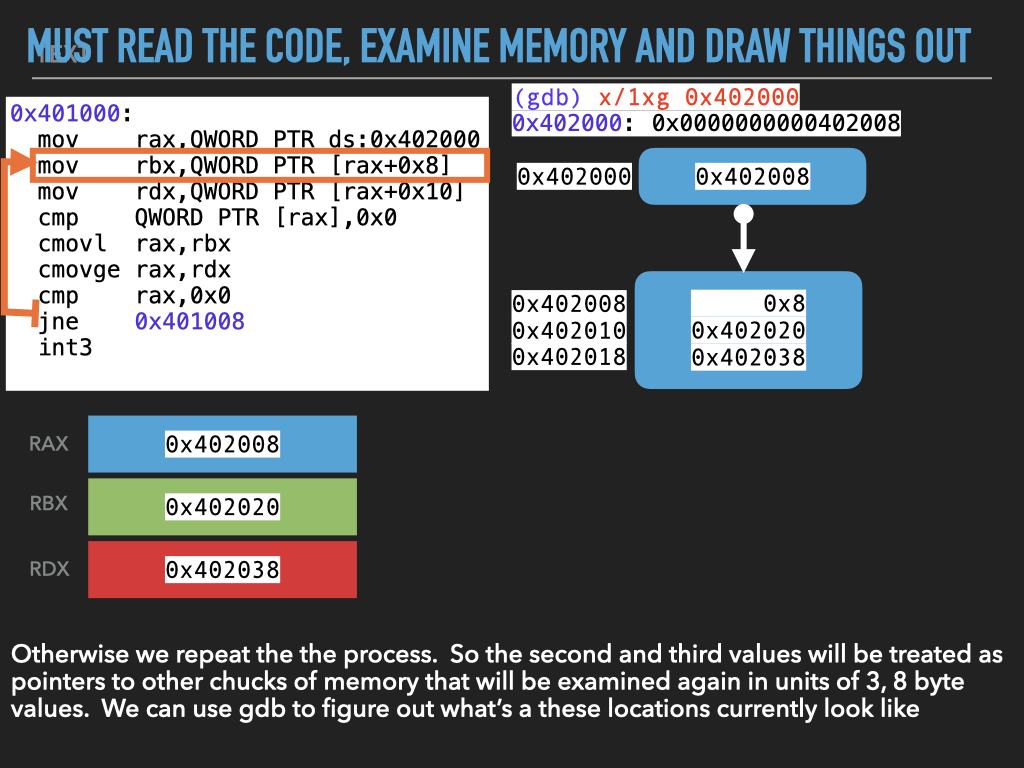

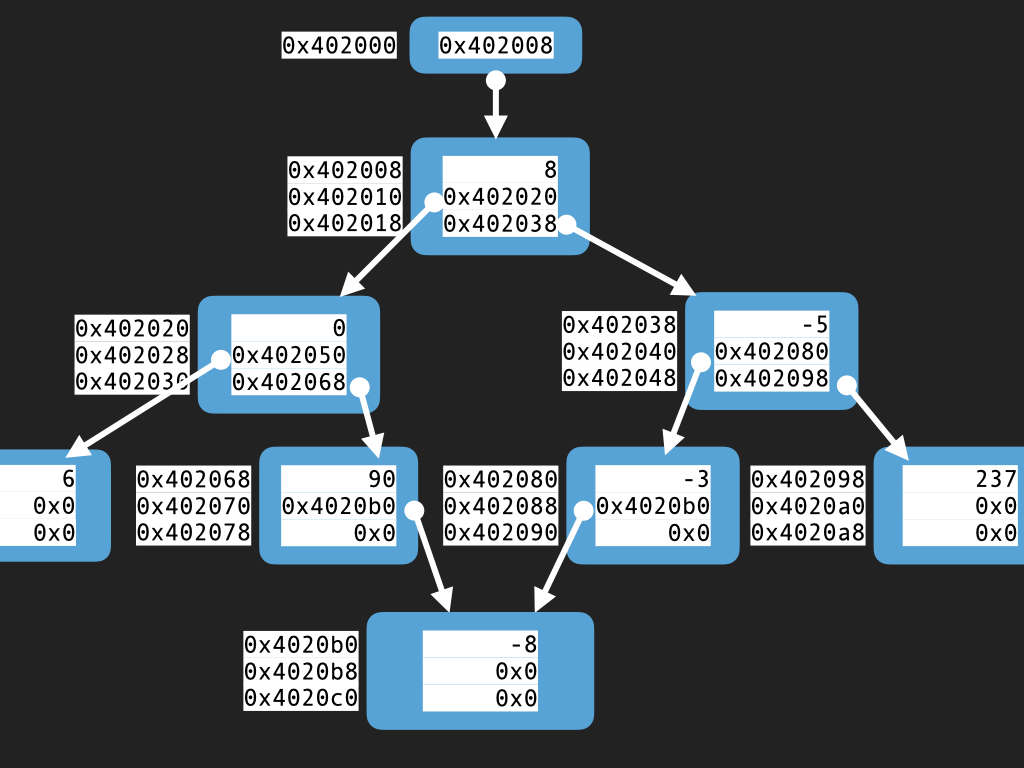
13.2. Worth carefully examining the assembly for this example#
Understanding this code is a great test of your knowledge
CODE: asm - tree.S
.intel_syntax noprefix
# TREE NODE STRUCTURE IN MEMORY
# A NODE is composed of 3, 8 byte values
# First 8 bytes is an 8 byte signed value
# Second 8 bytes is a pointer to the left child (another node)
# Third 8 bytes is a pointer to the right child (another node)
# a 0 value pointer means there are no nodes in that direction
# node.VAL
# node.LEFT
# node.RIGHT
.equ VAL, 0 # tree node value 8 bytes (offset 0)
.equ LEFT, 8 # pointer to left child 8 bytes (offset 8)
.equ RIGHT, 16 # pointer to right child 8 bytes (offset 16)
.section .text
.global _start
_start:
mov rax, QWORD PTR [ROOT] # pointer to root node is in a memory location ROOT
loop:
mov rbx, QWORD PTR [rax + LEFT] # rbx = left child location
mov rdx, QWORD PTR [rax + RIGHT] # rdx = right child location
cmp QWORD PTR [rax + VAL], 0 # compare node's value to zero
cmovl rax, rbx # if val < 0 then rax = rbx -- left child
cmovge rax, rdx # if val >= 0 then rax = rdx -- right child
cmp rax, 0 # if location of next node is 0 we are done
jne loop # otherwise keep walking the tree
int3
.section .data
ROOT:
.quad N0 # ROOT global variable stores address of
# N0 node &N0 (eg points to N0)
# A BUNCH OF NODES CONNECTED TO FORM A TREE LIKE STRUCTURE
N0:
.quad 8 # N0.VAL = 8
.quad N1 # N0.LEFT = &N1
.quad N2 # N0.RIGHT = &N2
N1:
.quad 0 # N1.VAL = 0
.quad N3 # N1.LEFT = &N3
.quad N4 # N1.RIGHT = &N4
N2:
.quad -5 # N2.VAL = -5
.quad N5 # N2.LEFT = &N5
.quad N6 # N2.RIGHT = &N6
N3:
.quad 6 # N3.VAL = 6
.quad 0 # N3.LEFT = 0
.quad 0 # N3.RIGHT = 0
N4:
.quad 90 # N4.VAL = 90
.quad N7 # N4.LEFT = &N7
.quad 0 # N4.RIGHT = 0
N5:
.quad -3 # N5.VAL = -3
.quad N7 # N5.LEFT = &N7
.quad 0 # N5.RIGHT = 0
N6:
.quad 567 # N6.VAL = 567
.quad 0 # N6.LEFT = 0
.quad 0 # N6.RIGHT = 0
N7:
.quad -8 # N7.VAL = -8
.quad 0 # N7.LEFT = 0
.quad 0 # N7.RIGHT = 0
13.2.1. To assemble and link#
13.2.2. Exploring the tree with gdb#
set pagination off
set disassembly-flavor intel
x/1gx &ROOT
x/16xb 0x402008
x/8xh 0x402008
x/4xw 0x402008
x/2xg 0x402008
x/9i _start
b _start
run
display /x $rax
display /1dg $rax + 0
display /2gx $rax + 8
b loop
c
c
c
c
c
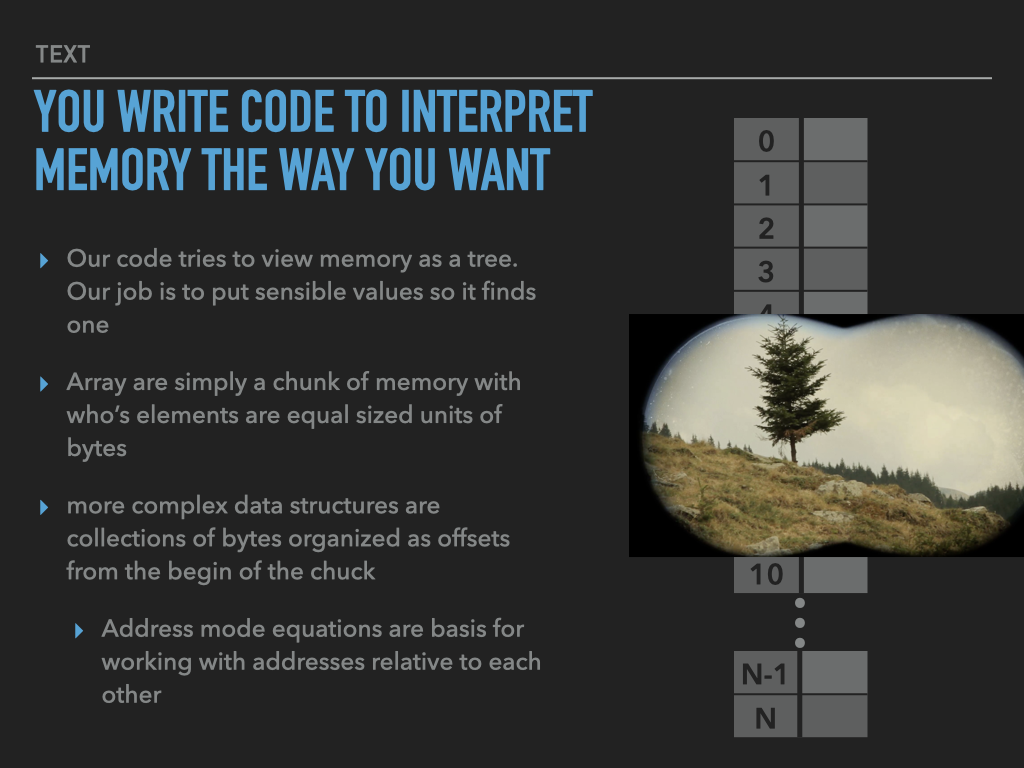
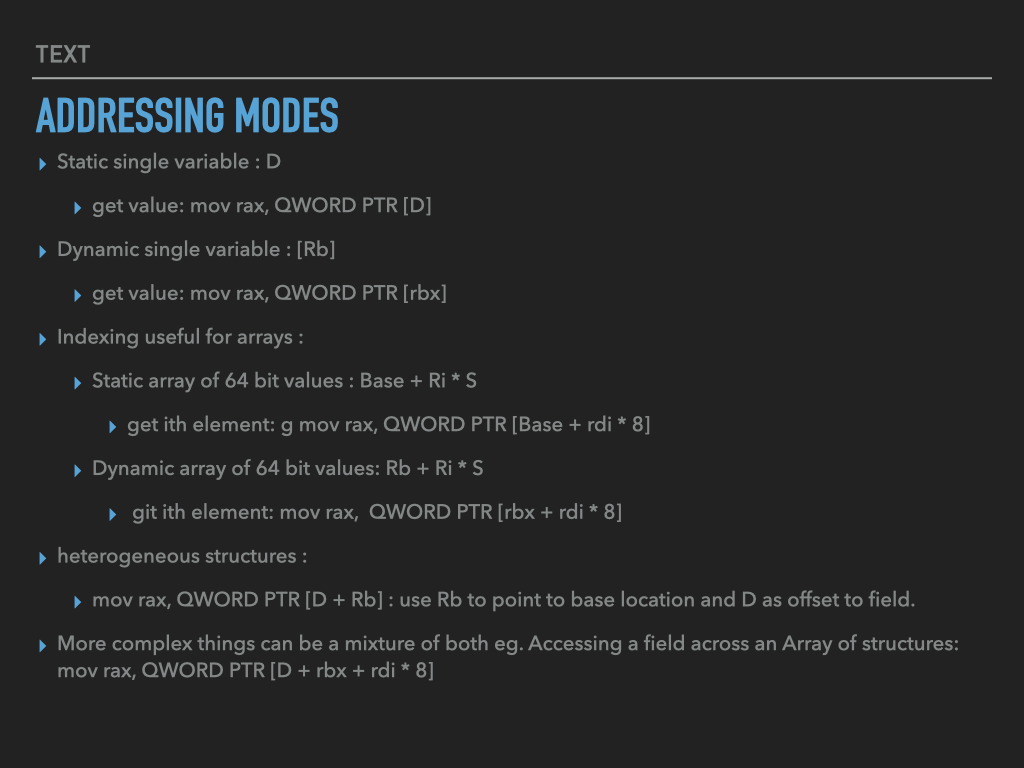
13.3. A more complex example#
This example should help to get your creative juices flowing and get a deeper appreciation for how we use the computer to write the kind of code you are used to.
Note I have not tested this much. I encourage you to try the exercises and test the code out.
13.3.1. The Story: An Array of Players#
Lets assume in our program we have an array of “Players”
Our program will have routines that work on the array and on individual players
In our example we will layout a static version of the array with a few players
Remember to draw things out to ensure you are understanding things
13.3.1.1. A Player#
Lets use a chuck of memory to represent a player
Each player has:
ID: A binary value that can fit in 8 bytes to uniquely identify a player
Name: A “string” : An array of ascii characters with 0 to mark the end of the string
maximum length of the string array is 80
Score: A four byte signed integer value
Age: A single byte unsigned integer value
13.3.1.2. The Array of Players#
Lets assume there is one global Array for the players
One symbol
PLAYER_ARRAYshould mark the beginning of the player ArrayOne symbol
PLAYER_ARRAY_ENDshould mark the end of the player Array
13.3.2. Our “main” program#
The following is our main program that has the “entry point”
in this case it will simply call our
find_player
It also lays out the memory for the static global player array
It initializes the players with some hard code players
When done exits passing the return value for find player as the process exit code
CODE: asm - playertest.S
.intel_syntax noprefix
.section .text
.global _start
_start:
mov rdi, OFFSET PLAYER_ARRAY
mov rsi, (PLAYER_ARRAY_END - PLAYER_ARRAY)/93 #ugly magic number
call find_player
mov rdi, rax
mov rax, 60
syscall
.data
PLAYER_ARRAY:
.quad 7 # id
.string "The Doctor" # name
.zero 80 - 11 # fill rest of name array with 0
.int 42 # score
.byte 255 # age
.quad 37 # id
.string "Bugs Bunny" # name
.zero 80 - 11 # fill rest of name array with 0
.int -4 # score
.byte 9 # age
PLAYER_ARRAY_END:
13.3.3. find_player#
This routine searches an Array of Players:
starting from the beginning of array
find the first player with capital ‘B’ in their name
Either returns the index of the found player or -1
Arguments: Address of the Array and length of the Array
CODE: asm - findplayer.S
.intel_syntax noprefix
# EXAMPLE ASSEMBLY CODE OF SOMETHING A LITTE MORE REALISTIC
# NOTE THIS IS BY NO MEANS MEANT TO BE THE MOST EFFICIENT
# OR ADVANCE WAY OF WRITING THIS CODE. RATHER IT IS MEANT
# TO BE SIMPLE AND HOPEFULLY CORRECT
# Player Structure
# id : 8 byte id
# name : 80 byte ascii encoded name
# score: 4 byte score
# age : 1 byte age
# total number of bytes for a player is 8 + 80 + 4 + 1 = 93
.equ PLAYER_STRUCT_SIZE, 93 # size of player structure in bytes
# offsets to start of each field
.equ PLAYER_ID_OFFSET,0 # offset 8 byte unsigned id
.equ PLAYER_NAME_OFFSET,8 # offset 80 byte ascii name
.equ PLAYER_SCORE_OFFSET, 88 # offset 4 byte score
.equ PLAYER_AGE_OFFSET, 92 # offset 1 Byte unsigned age
# Routine to search an array of player structures
# to find first player who's name contains a 'B'
# We assume the location of the array is passed in %rdi
# and %rsi contains the length of the array.
# Each element of the array is a player structure
# When done the index of the first player found that
# has a B in its name shoud be left in %rax.
# if not found then %rax should contain -1
# INPUTS
# rdi -> array : address of player array
# rsi -> len : length of player array
# OUTPUTS
# rax -> i : index of player with B in name or -1 if none found
# REGISTER USED AS TEMPORARIES
# rdx -> player_ptr : pointer to the ith player structure
# r8 -> j : temporary integer used to seach name
# r9b -> tmpc : temporary byte used to hold the jth charater of the current
# : player's name
.global find_player
find_player:
xor rax, rax # i = 0
jmp find_player_loop_condition
find_player_loop:
mov rdx, rax # player_ptr = i
imul rdx, PLAYER_STRUCT_SIZE # player_ptr = i * size of player stucture
add rdx, rdi # player_ptr += array starting address
# rdx now holds the address of the ith player
xor r8, r8 # j=0
name_search_loop:
# tmpc = player->name[j]
mov r9b, BYTE PTR [rdx + r8 + PLAYER_NAME_OFFSET]
cmp r9b, 'B' # compare tmpc to 'B'
je find_player_done # found a 'B' in the ith player name
cmp r9b, 0 # is the current character 0 if so end of name
je name_search_loop_end # done searching this player's name exit name loop
inc r8 # j++
jmp name_search_loop # goto top of name search loop to examine next byte in name
name_search_loop_end:
inc rax # i++
find_player_loop_condition:
cmp rax, rsi # if i < len
jl find_player_loop
find_player_notfound:
mov rax, -1
find_player_done:
ret
13.3.4. Assemble and link#
13.3.5. Exercises#
Modify the find routine to taking the search character as a parameter
Add more players
Write a routine to update a player’s score
Replace the Array with a list
convert static array with static list (see tree example for inspiration)
rewrite
find_playerto search a list
